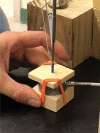Excessive Derotational K-Wire Angulation Decreases Compression by Headless Compression Screw
- PMID: 36339069
- PMCID: PMC9633144
- DOI: 10.1055/s-0041-1740136
Excessive Derotational K-Wire Angulation Decreases Compression by Headless Compression Screw
Abstract
Background Scaphoid fracture is the most common carpal bone fracture. Open reduction internal fixation of scaphoid fractures typically undergo stabilization by a single headless compression screw (HCS). During screw insertion, a derotational Kirschner wire (K-wire) is often placed for rotational control of the near and far fragment. Questions/Purposes The aim of this study was to determine if there is an angle of derotational K-wire placement in relation to the axis of a HCS that compromises the amount of compression generated at a fracture site by the HCS. We hypothesize that increased off-axis angle will lead to decreased compression across the fracture site. Methods A Cellular Block 20 rigid polyurethane foam (Sawbones, Vashon, WA) scaphoid model was created to eliminate variability in bone mineral density in cadaveric bone. MiniAcutrak HCS screws (Acumed, Hillsboro, OR) were used for testing. Three conditions were tested: (1) HCS with derotational wire inserted parallel to the HCS (zero degrees off-axis); (2) HCS with derotational wire inserted 10 degrees off-axis; and (3) HCS with derotational wire inserted 20 degrees off-axis. Results A statistically significant difference in the mean compression of the control group (56.9 N) was found between the mean compression with the derotational K-wire placed 20 degrees off-axis (15.2 N) ( p = 0.001). Conclusions Compression at the fracture site could be impeded by placing an excessively angulated off-axis derotation wire prior to insertion of the HCS. Clinical Relevance Our study adds a new detail to the optimal technique of HCS placement in scaphoid fractures to improve compression and fracture union.
Keywords: angulation; compression; derotational K-wire; headless compression screw; scaphoid fracture.
Thieme. All rights reserved.
Conflict of interest statement
Conflict of Interest None declared.
Figures


Similar articles
-
The Effect of Derotational Kirschner Wires on Fracture Gap Reduction With Variable-Pitch Headless Screws.J Hand Surg Am. 2023 Jan;48(1):86.e1-86.e7. doi: 10.1016/j.jhsa.2021.09.023. Epub 2021 Nov 19. J Hand Surg Am. 2023. PMID: 34802813
-
A Mechanical Comparison of the Compressive Force Generated by Various Headless Compression Screws and the Impact of Fracture Gap Size.Hand (N Y). 2021 Sep;16(5):604-611. doi: 10.1177/1558944719877890. Epub 2019 Sep 30. Hand (N Y). 2021. PMID: 31565968 Free PMC article.
-
The Effect of Intra-carpal Kirschner Wire Augmentation in Screw Fixation of Scaphoid - A Retrospective Cohort Study.Malays Orthop J. 2020 Nov;14(3):104-109. doi: 10.5704/MOJ.2011.016. Malays Orthop J. 2020. PMID: 33403069 Free PMC article.
-
Headless compression screw fixation of scaphoid fractures.Hand Clin. 2010 Aug;26(3):351-61, vi. doi: 10.1016/j.hcl.2010.04.005. Epub 2010 Jun 18. Hand Clin. 2010. PMID: 20670800 Review.
-
Percutaneous fixation of scaphoid fractures.Hand Clin. 2001 Nov;17(4):553-74. Hand Clin. 2001. PMID: 11775468 Review.
References
-
- Raittio L T, Jokihaara J, Huttunen T T, Leppänen O V, Launonen A P, Mattila V M. Rising incidence of scaphoid fracture surgery in Finland. J Hand Surg Eur Vol. 2018;43(04):402–406. - PubMed
-
- Van Tassel D C, Owens B D, Wolf J M. Incidence estimates and demographics of scaphoid fracture in the U.S. population. J Hand Surg Am. 2010;35(08):1242–1245. - PubMed
-
- Larsen C F, Brøndum V, Skov O. Epidemiology of scaphoid fractures in Odense, Denmark. Acta Orthop Scand. 1992;63(02):216–218. - PubMed
-
- Jonsson B Y, Siggeirsdottir K, Mogensen B, Sigvaldason H, Sigursson G. Fracture rate in a population-based sample of men in Reykjavik. Acta Orthop Scand. 2004;75(02):195–200. - PubMed

